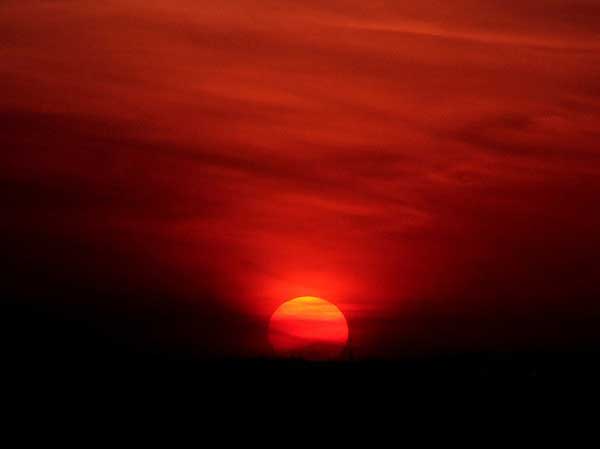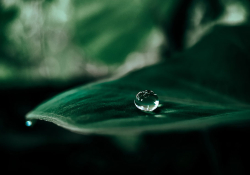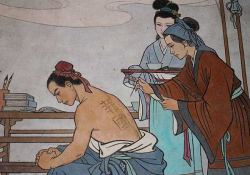The Transformative Effect of Color in the Poetry of Tomas Tranströmer

Nobel laureate Tomas Tranströmer is a poet of great spirituality and depth, but his language is deceptively simple. The following essay examines Tranströmer’s painterly use of simple colors against a monochrome background to create and signal a shift to the extraordinary, and concludes that this aspect of Tranströmer’s work, on the analogy to painting, has a universal appeal that resonates easily across cultures and languages.
In the poetry of the poet and the thinking of the thinker, there is always so much worldspace to spare that each and every thing—a tree, a mountain, a house, the call of a bird—completely loses its indifference and familiarity.
– Martin Heidegger, “The Fundamental Question of Metaphysics”
Reading the work of Swedish poet Tomas Tranströmer, one is struck by a sense of its ethereal power, its almost otherworldly presence. It is perhaps this effect that has prompted critics to note a “mysterious glow,” a sense of “mystery or surprise,” and an “inherent religiosity . . . [a] constant openness to the unknown, to that which has to remain unknown to retain its healing power” in his work.[1] Tranströmer’s various minimalist techniques—simple syntax and diction, short line structure, uncomplicated imagery—all contribute to this effect, but little has been written about another tool he employs: his limited color palette, and the way color effects a sudden shift from the “everyday” to the world of “strangeness” and “epiphany.”[2] In stylistically distinct poems written decades apart, Tranströmer establishes a monotone background—spare, disciplined, and black and white, the color palette matching the simple syntax and diction—against which he then brings forth a simple, vibrant (often primary or secondary) color.[3] This sudden color is often associated with the shift to the extraordinary, and (perhaps due to its reliance on simple visuals) it remains a highly translatable aspect of Tranströmer’s work.[4]
A sudden burst of color against a monotone background both creates and ushers in a moment of “strangeness” in “The Journey,” from Tranströmer’s early collection Den halvfärdiga himlen (The Half-Finished Heaven, 1962). In the poem, the speaker recounts a dull train ride:
Darkness next. We sat
in the carriages like statues,
hauled through the caverns.
. . .
In the stations under sea level
they sold news of the dark.[5]
There is a sense of vivaciousness, even humanity, being lost. The passengers become “like statues” being “hauled” (the passive construction here implies loss of subjectivity and agency); they are “under sea level,” cut off from everyday life. In this context, “news of the dark” sounds perhaps not so much ominous as irrelevant or dull. There are other bits of monotony: “Glances in all directions / on the journey through the mountain. / Still no change.” Suddenly, though, “a murmuring / of bees began—freedom.” The poem ends with a bit of surrealism connected to
a vibrant color:
The land beat its wings
once and became still
under us, widespread and green.
This sudden emergence of “green” after so much darkness, so much monotony, has a startling effect. In conjunction with the surrealistic animation of the land, the color green seems to have something to do with life and reanimation. It is impossible, after the dark, cramped train ride, not to find comfort and renewal in words like “widespread” and “freedom.” Yet the whole affair seems almost illusory—did it happen at all?—and thus somehow more mystical,[6] as if for a moment some barrier between the real and the surreal has collapsed, allowing just a glimpse before closing again.
The color green again creates and ushers in “strangeness”[7] in the stylistically distinct prose poem “The Clearing,” part of the 1978 collection Sanningsbarriären (The Truthbarrier). The poem begins with the striking line: “Deep in the forest there’s an unexpected clearing that can be reached only by someone who has lost his way.” This opening irony—an “unexpected” clearing that can only be found by one who is already “lost”—primes the reader for the unexpected, the surreal. This is not a place one seeks, but a place one happens upon, and only when one has reached the disoriented (and disorienting) state of being lost. In the forest, everything is “black” or “ashy,” “shadow brooding on shadow.” Color seeps in gradually, beginning with “a few solitary green twigs [which] touch the light.” Then, suddenly, we arrive at the mystical clearing, which is at once the central image of the poem and the center of the forest—and this transition is signaled by a sudden burst of color: “But in the open space the grass is unexpectedly green and alive.” Beginning the paragraph with “But” signals the abrupt turn from the “black” “ashy,” “dead” world of the forest to the world of the clearing, and this “unexpected” color links again to reversal of expectation (“unexpected,” “unexpectedly alive”) and a sense of “strangeness,” to use Fulton’s term. At this point in the poem, the speaker encounters the mysterious old homestead, the old stone foundation of which “murmurs with voices”—the speaker calls it “the center of the world” and “a sphinx” that feels vaguely (perhaps unexpectedly) familiar (“Somehow I’ve been here before”). Once again, the sudden emergence of a simple color is associated with a turn toward the extraordinary.
In “Further In,” a poem from the 1974 collection Stigar (Paths), a single vibrant color signals the shift from the mundane to the extraordinary. In the poem, a driver stuck in traffic (beautifully imagining himself one of the scales in the “sluggish dragon” that is the traffic) is called forth from the everyday into a different sphere by “the red sun”:
Suddenly the red sun is
right in the middle of the windshield
streaming in.
I am transparent
and writing becomes visible
inside me
words in invisible ink
that appear
when paper is held to the fire!
The enjambment creates a clever double entendre—“the red sun is,” it exists, it is there, and its emergence is notable in itself, regardless of where it is or what it does. Moreover, it is literally “right in the middle” in two senses—it is in the middle of the windshield and it is the central “act” of the poem, the turn or driving force. Color has again entered and transformed, “streaming in” and creating something otherworldly even in the midst of a most mundane situation. The experience with the sun is transformative—the speaker is drawn forth from the traffic jam into the forest, where he encounters a “precious” stone:
It can change everything
it can make the darkness shine.
It is a switch for the whole country.
Again, the sudden emergence of color in the poem drags us out of the “normal” world and beckons us into the “strangeness.”[8]
Tranströmer’s use of color invites thinking of his poems as paintings…they share a tendency to be independent of the language in which they were produced, and to have an appeal across language and culture.
Tranströmer’s interest in the transfiguring effect of color can also be seen in a poem specifically about a painting—“Vermeer,” from the 1989 collection För levande och döda (For the Living and the Dead). In the poem, Tranströmer mentions two Vermeer paintings, The Music Lesson and Woman in Blue Reading a Letter, though, as Bergsten points out, he focuses primarily on the latter picture, which becomes “the central motif in Tranströmer’s poem.” In the painting, a woman (Tranströmer imagines that she is eight months pregnant with twins) reads a letter by a window through which light streams. As in one of Tranströmer’s poems, color is rigidly controlled:
Blue is the dominant color of the whole painting: the maternity dress, the upholstery, and even the wall by the side of the map. . . . In Tranströmer’s poem it is transubstantiated into a mysterious quality, as are the brass tacks, which become gold rivets.[9]
The light from the window illuminates the vivid blue and the gold rivets against an otherwise rather drab background. Perhaps Tranströmer was drawn to the simple color composition in the painting itself—he highlights these colors in the poem:
Breathe calmly . . . An unknown blue material is nailed to the chairs.
The gold studs flew in with incredible speed
and stopped abruptly
as if they had never been other than stillness.
The way Tranströmer sees the painting—and the fact that he picks this particular painting—is unsurprising: as in his poetry, so in the painting the vivid blue seems to possess some “mysterious quality,” and Bergsten sees an ironic force emanating from the static gold rivets, as if the “tranquility is, like the painting as a whole, charged with great energy.”[10]
Focusing on Tranströmer’s use of color invites thinking of his poems as paintings, and the analogy is instructive: they share a tendency to be independent of the language in which they were produced, and to have an appeal across language and culture. Indeed, when the poet was awarded the Neustadt Prize by the University of Oklahoma in 1990, several critics discussed the “universality” of Tranströmer’s appeal and how well the poetry translated to other languages. Robert Bly noted that Tranströmer’s poetry remains “so vivid in English” and “show[s] the ability of certain poetry to travel to another culture and actually arrive there.” Ivar Ivask, noting that Tranströmer’s poetry had “been translated into more than thirty languages” noted that “Tranströmer is not a poet merely of words but rather has a strong individual language which transmits and can be translated,” and Czesław Miłosz made a case, which he conceded was “not ideal,” for relying on English translations (not Swedish originals) to render Tranströmer’s poetry in Polish, confident that he could translate the “spark” to Polish even when translating a translation.[11] The simplicity of his color composition is perhaps but one reason for this—the painterly effect he achieves is less dependent on the intricacies of any particular language or syntax. Tranströmer himself, in his acceptance speech, seemed to endorse this idea, proposing “another . . . view” of poetry in translation:
[T]he poem as it is presented is a manifestation of another, invisible poem, written in a language behind the common languages. Thus, even the original version is a translation. A transfer into English or Malayalam is merely the invisible poem’s new attempt to come into being. [12]
If all poems are already, in a sense, translations, then every poem in any language presupposes the possibility of translation—that is, the possibility that translation can preserve at least some of the potency of the “original” poem. In a passage from Östersjöar (Baltics, 1974), Tranströmer again downplays the importance of any particular language or words in favor of “style”:
Something wants to be said but the words don’t agree
Something which can’t be said,
aphasia,
there are no words but perhaps a style
Whether “style” is, as a general matter, more easily preserved in translation is a fraught question; however, Tranströmer’s style, due in part to his painterly use of simple colors and his reliance on an almost “visual” mechanics, seems highly translatable. And perhaps this is a final way of looking at the element of color in his poetry—perhaps this controlled, extraordinary use of color is an aspect of a style that, ultimately, is of vital importance regardless of the particular language in which it is rendered.
Los Angeles, California
[1] All quotations are from the Autumn 1990 issue of World Literature Today: Staffan Bergsten, “To Go Through Walls: Tomas Tranströmer’s ‘Vermeer,’” trans. Steven Sondrup, 585; Robert Bly, “Tomas Tranströmer and ‘The Memory,’” 571; Ivar Ivask, “The Universality of Openness: The Understated Poetry of Tomas Tranströmer,” 549.
[2] “[T]his fascination with the borders between sleep and waking, with the strange areas of access between an everyday world we seem to know and another world we can’t know in the same way but whose presence is undeniable—such a fascination has over the decades been one of Tranströmer’s predominant themes.” Robin Fulton, foreword to The Great Enigma: New Collected Poems, by Tomas Tranströmer, trans. Robin Fulton (New Directions, 2006), vix. Fulton also notes that “in poems like ‘Secrets on the Way’ and ‘Tracks’ . . . a series of contrasts, or similes, or just luminously clear images are grouped as if around a central space where some kind of epiphany is happening. Such poems end by returning us, perhaps abruptly, to an active world, but they leave us with the feeling that a strangeness has crossed our path” (xv). “Strangeness” as used throughout is meant to refer to Fulton’s usage of the term.
[3] In correspondence with the author, translator Patty Crane invokes the Swedish climate in discussing this aspect of Tranströmer’s work, comparing his use of color to “those hand-painted black and white photos . . . when the colorist has a light touch, choosing key images or parts of images to highlight so the color merely accents rather than defines. When you consider the Swedish landscape . . . with its deep seasonal contrasts, the world he inhabits is, in a way, like those hand-painted black and whites. Winter is gray. Gray, gray, gray. Or grå, grå, grå. . . . Summer, on the other hand, is all about the light. . . . [T]he Swedish summer light . . . draws colors out in astonishing ways.” Crane confirms that “[Tranströmer’s] colors are pretty straightforward and thus easily rendered into English. . . . [h]is word-color palette is basic. No siennas or chartreuses. . . . Generally, Tranströmer seeks the plainest diction, and color is no exception.” Patty Crane, correspondence with author, June 27, 2012.
[4] I am grateful to David Cairy’s comment linking Tranströmer’s poem “The Half-Finished Heaven” to M. Night Shyamalan’s The Sixth Sense, in which the color re4d is densely symbolic. That image helped spur my own thinking on this topic.
[5] Tranströmer, The Great Enigma, 53. All citations to Tranströmer’s work, and all translations thereof, are from The Great Enigma: New Collected Poems, trans. Robin Fulton (New Directions, 2006).
[6] A label, as Fulton points out, that Tranströmer avoids. Fulton, foreword, xiv.
[7] Fulton, foreword, xiv–xv.
[8] Similar effects can be seen in other poems, for example, “The Couple” (Tranströmer 49) and “Face to Face” (Tranströmer 50) from the 1962 collection Den halvfärdiga himlen (The Half-Finished Heaven).
[9] Bergsten, “To Go Through Walls,” 587, 588.
[10] Bergsten, “To Go Through Walls,” 588. In this regard, Bergsten notes: “Another characteristic quality of Vermeer’s interior paintings, the light which flows in from the outside world through a side window, unseen in the painting, could with a somewhat bolder analogy be said to correspond to the mysterious glow in many of Tranströmer’s poems—a glow which, without naming or revealing the transcendent source of the light, transfigures the piece of earthly reality that is the material of the poem” (Bergsten 585).
[11] Bly, “Tomas Tranströmer and ‘The Memory,’” 570; Ivask, “Universality of Openness,” 549; Miłosz, “Three Poems by Tomas Tranströmer,” World Literature Today 64.4 (Autumn 1990): 560.
[12] Tomas Tranströmer, “Laureate’s Words of Acceptance,” World Literature Today 64.4 (Autumn 1990): 552-553








